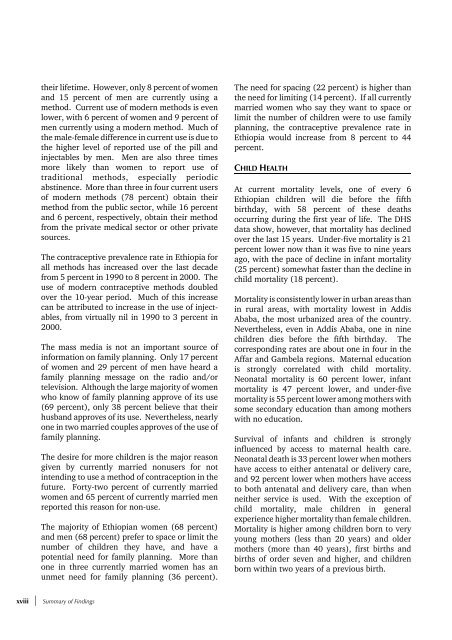PDF, 1536K - Measure DHS
PDF, 1536K - Measure DHS
PDF, 1536K - Measure DHS
You also want an ePaper? Increase the reach of your titles
YUMPU automatically turns print PDFs into web optimized ePapers that Google loves.
their lifetime. However, only 8 percent of women<br />
and 15 percent of men are currently using a<br />
method. Current use of modern methods is even<br />
lower, with 6 percent of women and 9 percent of<br />
men currently using a modern method. Much of<br />
the male-female difference in current use is due to<br />
the higher level of reported use of the pill and<br />
injectables by men. Men are also three times<br />
more likely than women to report use of<br />
traditional methods, especially periodic<br />
abstinence. More than three in four current users<br />
of modern methods (78 percent) obtain their<br />
method from the public sector, while 16 percent<br />
and 6 percent, respectively, obtain their method<br />
from the private medical sector or other private<br />
sources.<br />
The contraceptive prevalence rate in Ethiopia for<br />
all methods has increased over the last decade<br />
from 5 percent in 1990 to 8 percent in 2000. The<br />
use of modern contraceptive methods doubled<br />
over the 10-year period. Much of this increase<br />
can be attributed to increase in the use of injectables,<br />
from virtually nil in 1990 to 3 percent in<br />
2000.<br />
The mass media is not an important source of<br />
information on family planning. Only 17 percent<br />
of women and 29 percent of men have heard a<br />
family planning message on the radio and/or<br />
television. Although the large majority of women<br />
who know of family planning approve of its use<br />
(69 percent), only 38 percent believe that their<br />
husband approves of its use. Nevertheless, nearly<br />
one in two married couples approves of the use of<br />
family planning.<br />
The desire for more children is the major reason<br />
given by currently married nonusers for not<br />
intending to use a method of contraception in the<br />
future. Forty-two percent of currently married<br />
women and 65 percent of currently married men<br />
reported this reason for non-use.<br />
The majority of Ethiopian women (68 percent)<br />
and men (68 percent) prefer to space or limit the<br />
number of children they have, and have a<br />
potential need for family planning. More than<br />
one in three currently married women has an<br />
unmet need for family planning (36 percent).<br />
The need for spacing (22 percent) is higher than<br />
the need for limiting (14 percent). If all currently<br />
married women who say they want to space or<br />
limit the number of children were to use family<br />
planning, the contraceptive prevalence rate in<br />
Ethiopia would increase from 8 percent to 44<br />
percent.<br />
CHILD HEALTH<br />
At current mortality levels, one of every 6<br />
Ethiopian children will die before the fifth<br />
birthday, with 58 percent of these deaths<br />
occurring during the first year of life. The <strong>DHS</strong><br />
data show, however, that mortality has declined<br />
over the last 15 years. Under-five mortality is 21<br />
percent lower now than it was five to nine years<br />
ago, with the pace of decline in infant mortality<br />
(25 percent) somewhat faster than the decline in<br />
child mortality (18 percent).<br />
Mortality is consistently lower in urban areas than<br />
in rural areas, with mortality lowest in Addis<br />
Ababa, the most urbanized area of the country.<br />
Nevertheless, even in Addis Ababa, one in nine<br />
children dies before the fifth birthday. The<br />
corresponding rates are about one in four in the<br />
Affar and Gambela regions. Maternal education<br />
is strongly correlated with child mortality.<br />
Neonatal mortality is 60 percent lower, infant<br />
mortality is 47 percent lower, and under-five<br />
mortality is 55 percent lower among mothers with<br />
some secondary education than among mothers<br />
with no education.<br />
Survival of infants and children is strongly<br />
influenced by access to maternal health care.<br />
Neonatal death is 33 percent lower when mothers<br />
have access to either antenatal or delivery care,<br />
and 92 percent lower when mothers have access<br />
to both antenatal and delivery care, than when<br />
neither service is used. With the exception of<br />
child mortality, male children in general<br />
experience higher mortality than female children.<br />
Mortality is higher among children born to very<br />
young mothers (less than 20 years) and older<br />
mothers (more than 40 years), first births and<br />
births of order seven and higher, and children<br />
born within two years of a previous birth.<br />
xviii * Summary of Findings








![Obtaining Informed Consent for HIV Testing [QRS4] - Measure DHS](https://img.yumpu.com/49850117/1/190x245/obtaining-informed-consent-for-hiv-testing-qrs4-measure-dhs.jpg?quality=85)








